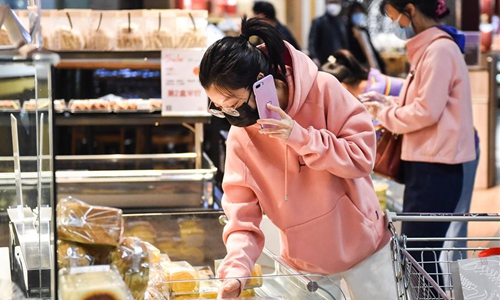HOME >> SOURCE
Consumer prices in China likely to further increase in March amid global coronavirus pandemic: analysts
By Shen Weiduo Source:Global Times Published: 2020/4/7 18:48:40
Rising food prices may signal broader impact of global pandemic

Customers shop in a supermarket in Taiyuan, North China's Shanxi Province, March 20, 2020. Photo:Xinhua
Consumer prices in China have stayed high in recent months and further increases are likely because of the global coronavirus pandemic, possibly leading to stagflation amid downward pressure on the world's second-largest economy, experts warned.
The cost of eating out has already surged, as many major restaurants have raised their menu prices after resuming operation in recent weeks, citing rising expenses for anti-pandemic efforts such as disinfection and higher raw material costs due to the virus' impact.
For instance, popular hot pot chain Haidilao raised its menu prices after resuming operation, citing the increasing cost of ingredients during the COVID-19 outbreak. The restaurant said price hikes will vary from city to city but won't be more than 6 percent.
Beijing-based restaurant chain Xibei reportedly raised its menu prices after its revenue slumped 87 percent year-on-year during the Spring Festival holidays.
Higher restaurant prices may signal a broader trend in food costs in the coming weeks, analysts said.
"Tightened food export policies adopted by many countries, as well as loosened monetary policies worldwide, could be an accelerator for food prices in China," Cong Yi, a professor at the Tianjin University of Finance and Economics, told the Global Times Tuesday.
Data from the National Bureau of Statistics showed that compared with mid-March, the price of soybean meal in late March, for which China is heavily reliant on imports, was up 9.7 percent, while hog prices were down 4.1 percent, showing a recovery from the African swine fever.
The worsening global pandemic will cause "much uncertainty" for food prices in the domestic market in the near future - especially for pork and soybeans, Dong Dengxin, director of the Finance and Securities Institute at Wuhan University of Science and Technology, told the Global Times on Tuesday.
Cong estimated that the March consumer price index (CPI) will show a rise of 5-6 percent, and gains may continue in April or even May as the spread of the pandemic continues to exert pressure on the supply side around the world.
Food prices account for nearly one-third of the weighting in China's CPI, the main gauge of inflation.
The combination of business and consumer activity that's yet to recover and a high inflation risk "may bring China's economy to the brink of stagflation," Cong cautioned.
China's CPI soared to 5.4 percent year-on-year in January, the highest level since November 2011. The figure edged down to 5.2 percent in February - still relatively high compared with normal conditions.
Experts noted that first two months above 5 percent CPI growth have already been a result of government adjustment - the actual figure could be even higher.
In the next two months, the central government may step up efforts to prevent food prices from surging further, they said.
"Sticking to structural adjustment is also needed to prevent stagflation risks, and China has not given up that effort during its fight against the virus," Cong said.
"Price hikes for food, and even other daily necessities in the near future, are possible not only in China but around the world amid the tough fight against the COVID-19," Cong said.
Newspaper headline: China facing stagflation risk: experts
Posted in: ECONOMY,BIZ FOCUS